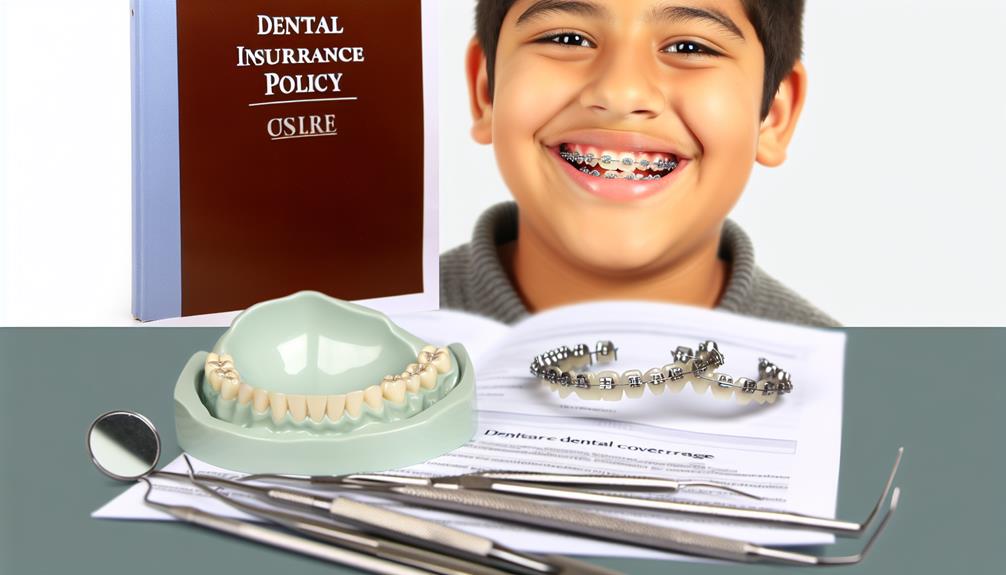Dental insurance coverage for braces varies widely among plans and is influenced by the type of policy—HMO or PPO. PPO plans generally offer a percentage of reimbursement after deductibles, while HMO plans may impose stricter limitations. Most policies prioritize coverage for children, often requiring proof of medical necessity for orthodontic treatment. Age restrictions further complicate coverage, with adults often facing exclusion altogether. Additionally, cosmetic treatments may not be covered. Understanding the nuances of your specific insurance plan is vital for maximizing benefits, ensuring you are well-prepared for any financial responsibilities related to orthodontic care. More information can clarify your options further.
Key Takeaways
- Dental insurance coverage for braces varies significantly between HMO and PPO plans, affecting overall costs and reimbursements.
- Most plans prioritize coverage for children's orthodontic treatment, focusing on medically necessary cases rather than cosmetic enhancements.
- Age limitations often restrict orthodontic coverage, with full benefits typically available for those under 12 and limited options for adults over 25.
- Understanding exclusions, such as cosmetic procedures, is essential for managing expectations regarding orthodontic treatment reimbursements.
- Maximizing dental benefits can involve reviewing policies, scheduling treatments wisely, and exploring payment plans or third-party financing options.
Understanding Dental Insurance Basics

Understanding Dental Insurance Basics
Steering through the complexities of dental insurance requires a fundamental understanding of its core components. At the heart of this understanding lies essential dental terminology, which encompasses terms such as deductibles, co-pays, and maximum benefit limits. Knowledge of these terms is crucial for effectively maneuvering dental insurance policies. Additionally, understanding who can prescribe medications for anxiety, such as a healthcare professional's qualifications, can help patients better manage their overall health, including stress related to dental procedures.
Insurance premiums, the amount paid for coverage, can vary considerably based on the provider and the specific plan. It is essential to analyze these premiums alongside the coverage they provide, particularly concerning orthodontic treatments like braces. Many plans categorize dental services into preventive, basic, and major treatments, which directly influences what expenses are covered.
Moreover, understanding the nuances of coverage can foster a sense of belonging within the community of individuals seeking dental care. When patients are equipped with this knowledge, they can engage more confidently in discussions with their dental providers and insurance representatives. Ultimately, a thorough grasp of dental insurance basics empowers patients to make informed decisions that align with their dental health needs and financial circumstances, ensuring they receive the care they deserve.
Types of Dental Insurance Plans
When selecting a dental insurance plan, understanding the differences between HMO and PPO options is vital, as each offers distinct benefits and restrictions. During times of financial uncertainty, such as job changes, steering through these choices can feel overwhelming, but staying informed can help ease the stress of managing health care costs navigating the emotional journey. Additionally, coverage for orthodontics can vary greatly between these plans, affecting the overall cost and accessibility of braces. Evaluating these factors is essential for individuals seeking the best dental care for their needs.
HMO vs. PPO Plans
Two primary types of dental insurance plans, Health Maintenance Organization (HMO) and Preferred Provider Organization (PPO), offer distinct approaches to coverage and patient care. Understanding these differences can help individuals make informed choices that best suit their needs.
| Feature | HMO Advantages | PPO Flexibility |
|---|---|---|
| Cost | Lower premiums and out-of-pocket costs | Higher premiums but more choices |
| Provider Network | Limited to in-network providers | Broader network, including out-of-network options |
| Referral Requirements | Requires referrals for specialists | No referrals needed for specialists |
HMO plans tend to offer reduced costs, making them appealing for those seeking affordable dental care. However, they require members to choose from a limited network of providers. Conversely, PPO plans provide greater flexibility, allowing members to select from a wider range of dental professionals, though at a higher cost. This flexibility can be particularly beneficial for those with specific dental needs or preferences. Ultimately, the choice between HMO and PPO plans should align with individual financial situations and healthcare expectations.
Coverage for Orthodontics
Maneuvering the complexities of dental insurance can be particularly challenging when it comes to coverage for orthodontics, as policies vary considerably between different types of plans. Generally, orthodontic coverage is more prevalent in PPO plans, which often provide a percentage of reimbursement for treatment costs after the deductible is met. Conversely, HMO plans may limit coverage, requiring members to choose from a network of providers and often necessitating pre-approval for orthodontic services.
When examining coverage, it's essential to evaluate the specific orthodontic costs associated with treatment, as well as the typical treatment duration. Most plans cover only a portion of the costs, with lifetime maximums that can greatly affect out-of-pocket expenses. For instance, while some policies may cover 50% of the orthodontic fees up to a certain cap, others may not provide coverage until specific criteria are met.
Understanding these variations allows individuals to make informed decisions regarding their dental insurance options. By reviewing the details of coverage, including waiting periods and limitations, families can better prepare for the financial implications of orthodontic treatment. Ultimately, being well-informed fosters a sense of belonging and confidence in managing dental care choices.
Coverage for Orthodontic Treatment

Many families find themselves maneuvering the complexities of dental insurance coverage, particularly when it comes to orthodontic treatment. Understanding what is covered can greatly impact braces affordability and access to necessary care. Stress can also influence overall health, including dental health, and can lead to increased costs if not managed properly how stress affects health. Most dental insurance plans offer at least partial coverage for orthodontic services, typically involving braces. However, the extent of this coverage can vary widely.
In general, insurance policies may cover a percentage of the total cost of braces, but they often have an annual maximum that limits the payout. It is essential for families to review their specific policy details to identify any coverage caps, waiting periods, or exclusions related to orthodontics. Coverage is usually more robust for children, as preventive measures are prioritized.
Moreover, orthodontic specialists may be in-network or out-of-network, affecting out-of-pocket expenses. Families should consider consulting their insurance provider and orthodontic specialists to obtain cost estimates and treatment plans. This proactive approach not only clarifies the financial responsibilities but also helps in making informed decisions regarding braces. By understanding these nuances, families can navigate orthodontic treatment options that align with their financial capabilities and overall dental health goals.
Common Exclusions and Limitations
When considering dental insurance for braces, it is essential to understand the common exclusions and limitations that may impact coverage. Many plans exclude cosmetic procedures that are not deemed medically necessary, which can affect those seeking orthodontic treatment solely for aesthetic reasons. Understanding how to navigate emotional challenges during this time can be beneficial for patients facing such decisions, as effective strategies for healing may provide support. Additionally, age limitations may be imposed, restricting coverage based on the patient's age at the time of treatment.
Cosmetic Procedures Excluded
What are the typical exclusions found in dental insurance policies regarding cosmetic procedures? Most dental insurance plans specifically exclude coverage for cosmetic dentistry, categorizing many treatments as elective procedures. This means that procedures aimed primarily at enhancing appearance—such as teeth whitening, veneers, and certain types of bonding—are not covered. Insurers often view these treatments as non-essential, focusing instead on medically necessary dental care.
Additionally, many policies impose limitations on the reimbursement for orthodontic treatments, such as braces, when the primary motivation is aesthetic improvement rather than functional correction. For example, while braces may be covered for children to resolve bite issues, adult orthodontics aimed solely at aligning teeth for aesthetic purposes may not receive the same support.
Understanding these exclusions is fundamental for individuals seeking to navigate the complexities of dental insurance. By being informed, patients can better align their expectations and financial planning with the realities of coverage, ensuring they make choices that reflect both their healthcare needs and aesthetic desires. Ultimately, recognizing the boundaries set by insurance policies can empower individuals to pursue their dental goals more effectively, fostering a sense of community in shared experiences and challenges.
Age Limitations Apply
Age limitations are a common feature in dental insurance policies, particularly concerning orthodontic treatments such as braces. Many plans impose specific age requirements that dictate eligibility criteria for coverage. Understanding these limitations is important for families seeking orthodontic care for their children or themselves.
| Age Group | Coverage Eligibility | Common Limitations |
|---|---|---|
| Under 12 years | Full coverage | May require prior approval |
| 12-18 years | Partial coverage | Age restrictions apply |
| 19-25 years | Limited coverage | Exclusions for adults |
| Over 25 years | No coverage | Often not eligible |
Typically, insurance policies are more accommodating for younger patients, aligning with the common practice of initiating orthodontic treatment during the formative years. As individuals age, they may find themselves subject to stricter limitations or completely excluded from coverage. Consequently, it is essential to review your dental insurance plan to identify any age-related exclusions before proceeding with orthodontic treatment. This knowledge empowers policyholders to make informed decisions about their dental health, ensuring they receive the necessary support while managing the complexities of insurance coverage.
How to Maximize Your Benefits

To maximize your dental insurance benefits for braces, it is vital to understand the specifics of your coverage and the associated costs. Many individuals find that exploring flexible work arrangements, such as embracing remote roles, can help them allocate funds toward their orthodontic care. Begin by thoroughly reviewing your policy to identify what is covered, including limits on reimbursements and the types of braces eligible for coverage. This knowledge allows you to make informed decisions and avoid unexpected expenses.
Understanding deductibles is essential. Make sure you know the amount you must pay out-of-pocket before your insurer starts covering expenses. By scheduling your treatment strategically, you can potentially align your orthodontic work with the renewal of your insurance benefits, which may help in maximizing reimbursements.
Communicating with your orthodontist's office can also be beneficial. They often have experience working with various insurance plans and can assist in submitting claims properly. Additionally, inquire about pre-authorization for your treatment to confirm coverage before starting.
Financial Options Beyond Insurance
While dental insurance can greatly alleviate the cost of braces, exploring additional financial options is vital for many families seeking orthodontic treatment. Understanding these alternatives enables families to make informed decisions that align with their financial situations.
One common approach is to inquire about payment plans offered by orthodontic practices. These plans typically allow families to spread the cost of treatment over several months, making it more manageable. By breaking down payments, families can avoid significant upfront costs and maintain their budgetary balance.
Additionally, many orthodontic offices provide financing options through third-party providers. These services often include low or no-interest financing, allowing families to pay for braces over an extended period without accruing excessive costs. It is important to review the terms and conditions of these financing options to guarantee they align with one's financial capabilities.
Lastly, some families might consider personal loans or health savings accounts (HSAs) to cover orthodontic expenses. Ultimately, exploring various financial avenues empowers families to navigate the costs associated with braces, making dental health accessible and manageable for all.
Frequently Asked Questions
Are Adult Braces Covered by Dental Insurance?
The coverage of adult braces by dental insurance varies considerably among plans. While some policies may include orthodontic options for adults, others may not cover braces costs at all. It is essential to review your specific dental insurance policy to determine the extent of coverage offered. Additionally, consulting with your orthodontist can provide insight into financing options and any additional costs that may arise during treatment, ensuring informed decision-making.
How Do Waiting Periods Affect Orthodontic Coverage?
Waiting periods can greatly impact orthodontic coverage limits, as they determine the timeframe during which benefits are unavailable after policy enrollment. These waiting period implications may lead to delays in receiving necessary orthodontic treatments, particularly for adults seeking braces. Consequently, individuals should carefully review their insurance policies to understand how waiting periods affect their access to coverage, ensuring they make informed decisions regarding their orthodontic care and financial planning.
Can I Use FSA or HSA for Braces?
When considering financial options for orthodontic treatment, both Flexible Spending Accounts (FSA) and Health Savings Accounts (HSA) present viable avenues. FSA eligibility typically allows for the use of funds toward braces, provided they align with medical necessity criteria. Similarly, HSA benefits facilitate pre-tax savings for orthodontic expenses. Utilizing these accounts can greatly alleviate out-of-pocket costs, making braces more accessible for individuals seeking to enhance their oral health and overall well-being.
What Documentation Is Needed for Insurance Claims?
When submitting insurance claims, understanding the specific documentation requirements is essential for a successful process. Typically, claim forms must be completed accurately and submitted alongside relevant documents, such as invoices, treatment plans, and any other necessary medical records. Ensuring that all required information is provided can expedite approval and enhance the likelihood of reimbursement. Familiarizing yourself with these documentation requirements will facilitate a smoother claims experience and foster confidence in managing your insurance.
Can I Appeal a Denied Orthodontic Claim?
Yes, you can appeal a denied claim through the appeal process. This typically involves reviewing the denial letter to understand the reasons for the denial, gathering necessary documentation, and submitting a formal appeal to your insurance provider. It is essential to adhere to any specified deadlines and include additional supporting evidence to strengthen your case. Engaging with your insurance company proactively can greatly enhance the likelihood of a successful resolution to denied claims.





